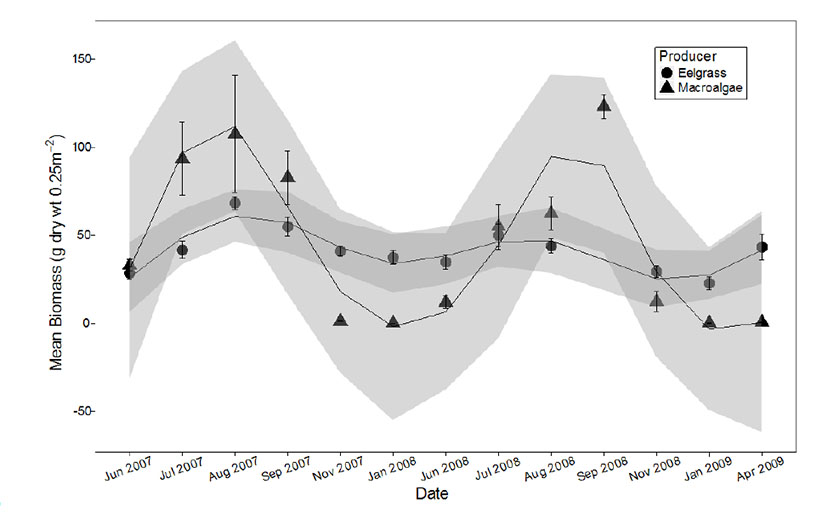
Ecological Archives A025-081-A1
Margot L. Hessing-Lewis, Sally D. Hacker, Bruce A. Menge, Sea-Oh McConville, and Jeremy Henderson. 2015. Are large macroalgal blooms necessarily bad? nutrient impacts on seagrass in upwelling-influenced estuaries. Ecological Applications 25:1330–1347. http://dx.doi.org/10.1890/14-0548.1
Appendix A. Temporal trends in macroalgal and eelgrass biomass (June 2007–April 2009) at field experiment location in Coos Bay, Oregon.
The results of an observational study of macroalgal and eelgrass production from June 2007 to April 2009 at the field experiment location in Coos Bay, Oregon (Fossil Point; 43°22'3"N, 124°18'11"W). We used haphazardly placed quadrats (0.25 m²) to quantify macroalgal production (N = 6), coupled with field collections of eelgrass biomass and density measurements (N = 10) from a permanent transect line (using the same methodology described in Hessing-Lewis et al. 2011). Smoother lines were fit to the data using natural splines from a linear model (df = 7) with gray bands around smoother lines representing 95% confidence intervals. We found mean (± SE) summer ulvoid biomass of 71 ± 13.3 g dry mass 0.25 m² at the field site, with peak blooms of 107.4 ± 33.1 g dry mass 0.25 m² (August 2007) and 123.0 ± 6.8 g dry mass 0.25 m² (September 2008) (Fig. A1). We found no evidence that eelgrass declined throughout the two years, despite large macroalgal blooms (Fig. A1). Rather, mean macroalgal and eelgrass biomass were positively correlated throughout the year (permutation test: r = 0.73, p = 0.01).
Fig. A1. Macroalgal and nutrient effects on seagrass in field and mesocosm experiments.
Literature cited
Hessing-Lewis, M. L., S. D. Hacker, B. A. Menge, and S. S. Rumrill. 2011. Context-dependent eelgrass-macroalgae interactions along an estuarine gradient in the Pacific Northwest, USA. Estuaries and Coasts 34:1169–1181.